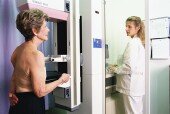
MONDAY, April 22 (HealthDay News) — Mammograms can be used to see how well breast cancer patients are responding to treatment with the drug tamoxifen, a new study suggests.
Researchers at the Karolinska Institute in Sweden report that women who saw a 20 percent or more reduction in breast density during tamoxifen treatment had a 50 percent lower risk of dying from breast cancer over an average of 15 years, compared with women who had little or no change in breast tissue density during treatment.
The study uncovered a link between reductions in breast density while on tamoxifen and a lowered risk of death. However, it didn’t find a cause-and-effect relationship.
Using mammograms to determine if a patient is responding to tamoxifen can be done at an early stage of treatment, the researchers added.
The Swedish team looked at nearly 1,000 postmenopausal women who had been treated for breast cancer. About half of them had been treated with tamoxifen, according to the study, which was published online April 22 in the Journal of Clinical Oncology.
Tamoxifen is a common hormone-therapy drug typically given over five years to prevent relapse in women who have completed their primary breast cancer treatment. However, there has been no way to assess which patients are most likely to respond to tamoxifen treatment.
These findings suggest a possible method for doing so, the researchers said.
“What’s needed is accurate measurement of mammographic density, which isn’t currently routine,” Per Hall, a professor in the department of medical epidemiology and biostatistics, said in a Karolinska Institute news release. “Measuring changes in density can be a simple and cheap means of assessing the effect of the treatment. If a patient is not responding to tamoxifen, maybe they should be given a different drug.”
More information
The U.S. National Cancer Institute has more about breast cancer treatment.

